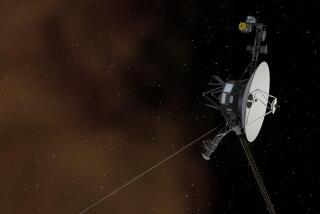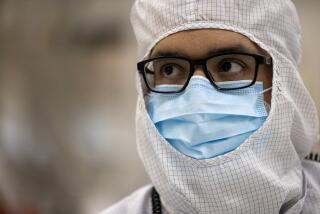Nuts-and-Bolts Approach Solves Space Problem : Science: Shuttle crewman, playing plumber to fix water leak, clears way for high-tech experiments to continue.
- Share via
HOUSTON — Astronaut Mark Lee put aside his scientific duties and played repair man Sunday, tightening two loose nuts to fix a small water leak that delayed experiments inside a $1-billion European-built laboratory aboard space shuttle Endeavour.
Lee took two hours to fix the leak in a water cooling system attached to furnaces used for some of the experiments aboard the shuttle, which blasted off Saturday for a planned seven-day mission.
“Everything is go from here. Thanks for the good work,” ground controller Julie Sanchez told Lee from the Marshall Space Flight Center in Huntsville, Ala.
Astronauts later activated four crucial furnaces linked to the water cooling system inside a laboratory rack, allowing eight major experiments to begin, National Aeronautics and Space Administration officials said.
Lee peeled away layers of insulation around a valve, looked at the leak with a dental mirror and tightened two packing nuts on the valve with a pair of pliers.
The experiments were delayed Saturday when the leak was discovered shortly after the shuttle reached its orbit about 165 miles above the Earth.
The seven-member crew has already managed to forge some high-tech alloys and other materials with equipment elsewhere within the laboratory that was unaffected by the leak.
Lee, who is in charge of science operations aboard the shuttle, noticed the leak when he and Japanese astronaut Mamoru Mohri unlocked the laboratory to go to work Saturday.
The furnaces will be used for heating, cooling and studying samples of high-tech metals, crystals and fiber composites.
NASA officials said earlier Sunday that shuttle operations were running smoothly as the mission, sponsored by Japan’s National Space Development Agency, entered its second day.
Endeavour was not expected to return to Earth until Saturday, but NASA officials said before liftoff that the mission might be extended to Sunday to give the crew an extra day of around-the-clock work on 43 major experiments.
Extending the mission would hinge on the crew conserving fuel and power, but so far they were being depleted too quickly to allow it, Mission Control chief Gary Coen said Sunday.
Scientists from Japan devised about 75% of the experiments and sent along Mohri, Japan’s first professional astronaut, to help conduct the tests.
Mohri, 44, was himself the object of a test Sunday when he wore a backpack full of medical instruments that monitored his body’s vital signs and sent the data to Earth.
One of two Japanese carp flipped over during the previous day’s rumbling rise to orbit but Lee said both of the orange-and-white fish both were “doing extremely well” in their separate tanks Sunday.
The fish, wearing electrodes on their heads, are subjects in studies of motion sickness. Half of all astronauts suffer such symptoms in space.






